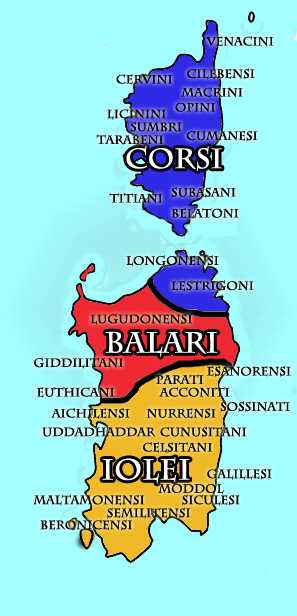Paleo-Sardinian language
| Paleo-Sardinian | |
|---|---|
| Nuragic | |
| Region | Corsica et Sardinia |
| Ethnicity | Nuragic civilization |
| Extinct | c. 2nd century AD |
| Language codes | |
| ISO 639-3 |
None (mis) |
| Glottolog | None |
|
Nuragic tribes | |
Paleo-Sardinian (Paleosardinian) or Paleo-Sardo (Paleosardo), also known as Nuragic, is an extinct language (or perhaps languages) spoken in Sardinia (and possibly Corsica) during the Bronze Age, which is thought to have left traces in the onomastics of the island and in the modern Sardinian language. By the third century, Latin had become the language of Sardinia, and the old language(s) survive mainly in toponyms, which appear to preserve grammatical suffixes, and in a few names of plants.
There is toponymic evidence suggesting that it may have had connection to Basque or to the pre-Indo-European Iberian language of Spain (Blasco Ferrer, 2010), or maybe to the ancient languages of Sicily.
Bertoldi & Terracini propose that the common suffix -ara (with stress on the antepenult) was a plural marker, and indicated a connection to Iberian or to the Paleo-Sicilian languages. Terracini claims a similar connection for the suffix -ànarV, -ànnarV, -énnarV, -ònnarV, as in the personal name Bonnànnaro. A suffix -ini also seems to be characteristic, as in the personal name Barùmini. A suffix or suffixes -arr-, -err-, -orr-, -urr- have been claimed to correspond to Numidia (Terracini), to Iberia (specifically Basque, Blasco Ferrer), to the south of Italy and Gascony (presumably Basque, Rohlfs), and to Basque (Wagner, Hubschmid).
The non-Latin suffixes -ài, -éi, -òi, -ùi survive in modern place names based on Latin roots. Terracini sees connections to Berber. Bertoldi sees an Anatolian connection in the endings -ài, -asài (similar claims have been made of the Elymians of Sicily). A suffix -aiko is also common in Iberia and may have a Celtic origin. The tribal suffix -itani, -etani, as in the Sulcitani, has also been identified as Paleosardinian.
Archeologist Giovanni Ugas suggested that the three main Nuragic peoples may have had separate origins and thus spoke different languages:
- the Balares from the Iberian peninsula (or Southern France) and possibly of proto-Iberian/Indo-European origin (Beaker culture)[1][2]
- the Corsi of the north-east and possibly of Ligurian origin
- the Iolei/Ilienses of the southern plains and Barbagia that probably spoke a pre-Indo-European language similar to Minoian and other languages of that area.[3]
The three modern dialects of Gallurese, Logudorese, and Campidanese might reflect that multilingual substratum.[4] Other minor Paleosardinian peoples of possible Indo-European stock were the Lugudonenses (may originally be from Provence, where is attested the toponym Lugdunum) of the north of the island and the Siculensi (perphans Siculi) of the Sarrabus region .[5]
See also
- Pre-Nuragic Sardinia
- Nuragic civilization
- List of Nuragic tribes
- History of Sardinia
- Prehistory of Corsica
Notes
References
- Eduardo Blasco Ferrer, ed. 2010. Paleosardo: Le radici linguistiche della Sardegna neolitica (Paleosardo: The Linguistic Roots of Neolithic Sardinian). De Gruyter Mouton.
- Ugas, Giovanni (2005). L'Alba dei Nuraghi. Cagliari: Fabula editrice. ISBN 88-89661-00-3.
